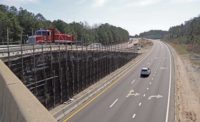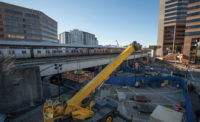As Hurricane Matthew’s curious, inverted question mark-shaped forecast tracks keep weather experts guessing, transportation agencies in the Southeast are taking no chances. Matthew is expected to become an extremely dangerous category 4 hurricane while it moves over the northwestern Bahamas and approaches the east coast of Florida, with peak surface winds reaching up to 145 mph near the eye.
The storm walloped Haiti and Cuba on Tuesday, but is expected to regain Category 4 intensity by the time the eye nears Florida’s central east coast, expected late Thursday. The death toll in Haiti had reached 136 by Thursday, CNN reported. Some 28,000 homes had sustained damage, officials said. "The situation is catastrophic," said President Jocelerme Prevert.
Cuban government officials had not released storm-related fatality figures by midday Thursday. The town of Baracoa in the eastern portion of the island was especially hard hit, with 90% of the homes sustaining damage from a storm surge reported as high as 24 ft. Five municipalities in Guantanamo province were cut off and 380,000 residents were displaced by the storm, United Nations officials told the Associated Press.
In Georgia, the Dept. of Transportation invoked restrictions Thursday morning in the costal region on all activities that entail traffic interruptions on evacuation routes for the duration of the storm, says Jill J. Nagel, communications officer for the Southeast Georgia district.
Nagel says the agency has advised its contractors to secure job sites and traffic control devices on projects including I-95 interchange projects in Camden, Chatham and McIntosh counties and state route widening or resurfacing projects in Chatham, Charlton, Clinch, Liberty and Ware counties.
Highway contractors in Florida have been asked to lower cranes and high-mast lights and cover mounds of dirt and gravel, according to news reports. In South Carolina the Dept. of Transportation has notified contractors to prepare for shutdown. SCDOT Director of Communications Pete Poore adds that districts are being reminded to verify supply inventories and make sure service vehicles are fueled and ready.
“Now, we’re just waiting,” Poore says.
Along North Carolina's erosion-prone Outer Banks, the state's Dept. of Transportation has prepositioned equipment and crews on the barrier islands to quickly move sand and water off State Route 12, the sole highway linking the islands together and to the mainland.
On Tuesday, PCL Civil Constructors, Inc., began securing construction equipment building a replacement of the Herbert C. Bonner Bridge across Oregon Inlet, including relocating PCL's entire marine fleet working on the job to pre-designated “safe-harbor locations.”
“We expect the project site to be fully secured and evacuated by the close of business on Thursday so that our employees have adequate time to take care of their families in preparation for the storm,” says PCL Area Manager Jim Schneiderman. “We are working very closely with NCDOT, and will have staff on call at all times before, during and after the storm to react to any emergencies that may arise.”
Hurricane Matthew, which intensified into a Category 5 storm just 24 hours after reaching hurricane status Sept. 29, had been projected for several days to hug the Eastern Seaboard and roll northeast, potentially threatening many of the densely developed coastal areas that sustained the brunt of 2012’s Superstorm Sandy.
Weather patterns to the north recently have altered track predictions substantially, however, with most models now suggesting a brush with the East Coast of Florida followed by an eastward arc off Georgia and into the open Atlantic over the weekend—but with some models even suggesting a complete loop to threaten Florida a second time.
Although much of the East Coast may be spared, forecasters say conditions are favorable for Matthew to remain intact well into next week. Its rains and 145-mph winds were responsible for 11 deaths in Haiti and the Dominican Republic, according to news reports, with many areas still isolated by washed out bridges and disrupted communications.






Post a comment to this article
Report Abusive Comment